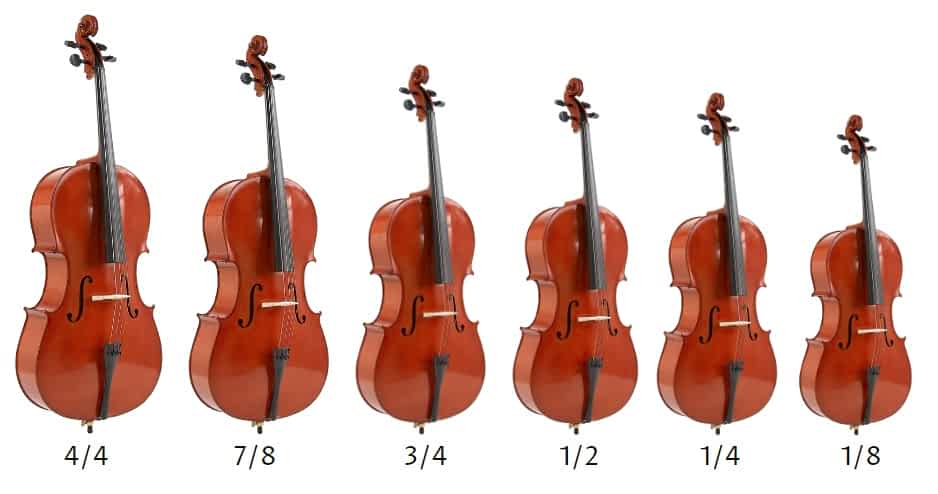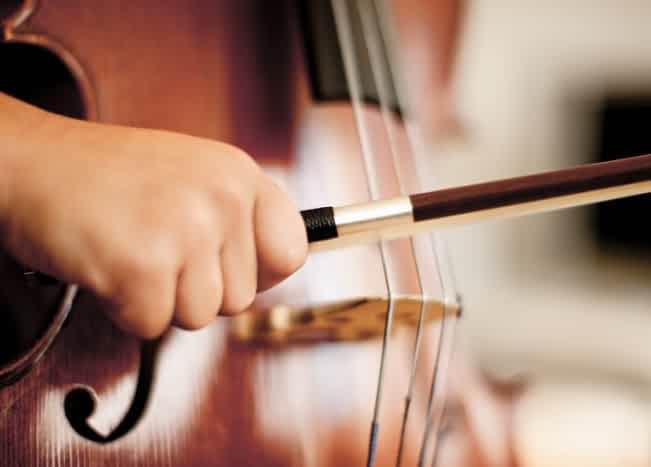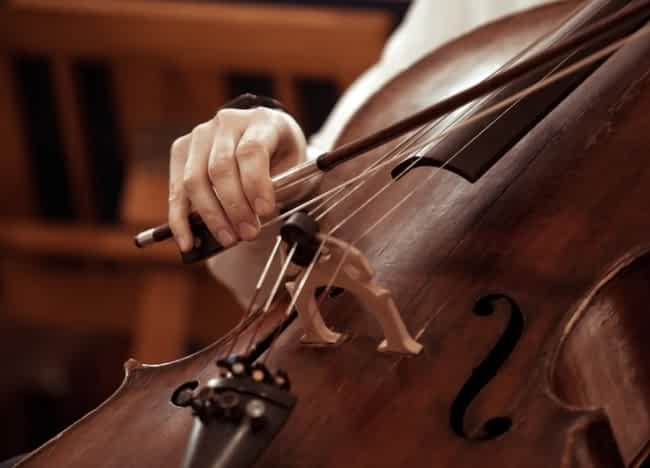Best
Cello for Beginners
-
Overall: Durable yet precise pau rosa tuning pegs
-
Best Feature: Solid tonewoods for a superior sound
-
TedScore™: 9/10
Best
PREMIUM QUALITY CELLO FOR BEGINNERS
-
Overall: Designed with attractively flamed maple back and sides
-
Best Feature: Redefines all expectations of a student cello outfit
-
TedScore™: 9.8/10
Best
BUDGET CELLO FOR BEGINNERS
-
Overall: Hand-carved maple and spruce body
-
Best Feature: Durable ebony pegs and fingerboard
-
TedScore™: 7.8/10
Choosing the right cello size is very important for anyone learning to play, no matter how old or good they are. Getting the perfect fit makes it easier to understand, master techniques, and have fun playing music.
Have you ever wondered why picking the right cello is like choosing a magic wand in Harry Potter? It’s because the wrong size can completely mess up your comfort and ability to play well.
In this article, we’ll explore how to measure your size and pick the best cello that feels right for you.
Ready to find your perfect match and make some beautiful music? Let’s start this exciting journey to discover your ideal cello size!
The Importance of Having the Right Cello Size
Proper Technique and Posture
Playing the cello that is the correct size ensures that the musician can maintain proper technique and posture. With an instrument that is too large or too small, achieving the correct positioning of the hands, arms, and body becomes challenging.
Too big can result in strained and uncomfortable hand positions, leading to difficulties in producing clear and accurate notes.Comfort and Ease of Playing
A well-fitted cello allows the musician to maintain a natural and relaxed playing position, reducing strain and fatigue during long practice or performance sessions.
When the cello size is appropriate, it facilitates the natural movement of the arms and hands, allowing smoother bowing and fingering techniques.Sound Quality and Projection
Selecting the right size helps achieve the desired sound and tonal qualities. A too-large or small cello may compromise sound projection, tone quality, and resonance.
Preventing Potential Injury
Playing a cello that's not the appropriate size can increase the risk of injury and physical strain.
Musicians who play a too-large cello may experience discomfort, muscle tension, and potential overextension of the arms and hands.
Selecting the right size minimizes the risk of injury and allows for a more sustainable and healthy playing experience.Development of Musicianship
Playing an instrument that fits properly from the beginning enables the musician to establish good habits and techniques.
It allows for better progress in developing proper bowing technique, finger dexterity, intonation, and musical expression.
With the right size, musicians can focus on refining their playing skills and musicality rather than struggling with an ill-fitted instrument.The Complete
Different Cello Sizes

1/8 Size Cello: It has a body length of around 36 inches, and the player’s left arm side length should be between 17 and 20 inches.
1/4 Size Cello: It has a body length of around 40 inches, and the length of the back and player’s arm length should be between 20 and 22 inches.
1/2 Size Cello: It has a body length of around 44 inches, and the player’s arm length should be between 22 and 24 inches.
3/4 Size Cello: It has a body length of around 47 inches, and the player’s arm length should be between 24 and 25.5 inches.
4/4 Size Cello: The body length is around 48 to 49 inches, and the player’s arm length should be at least 25.5 inches.
What Cello Size Do I Need?
Adults require a full-size cello (4/4) to get the desired tone, but some may have difficulty playing a larger instrument.
In such cases, a 7/8 size cello may be a suitable option. Various methods are available to measure the right size, such as counting from your neck to the floor or consulting a professional cellist.
A full-size cello’s neck is 3 times larger than a full-size violin, so keep this in mind when considering the size of your new instrument.
Cello sizing is important for comfort, playing ability, and sound production.
Measuring By Finger Span
Measuring the span from your left ear from fingertip to fingertip can give you an idea of what might be best suited for you.
They should be as long as your arm span, with the ¼ size ideal for children ages 7 to 9 and the 4/4 size for adults.
As a rule, each should be increased by one year for each additional player’s age.

For example, the ⅛ size is appropriate for children ages 5 to 7. Female cellists may find the ⅞ size more comfortable, as it’s ideal for teenagers 15 years and older.
Using the Suzuki Method of Sizing
While traditional sizing charts are widely used for finding the perfect size, the Suzuki Method provides an alternative approach.
One distinct difference is that smaller sizes using the Suzuki Method are a “size down” compared to traditional sizing.
Using the Suzuki Method of sizing cellos is precise and easy to follow, making it a popular choice for players of all levels.

This approach ensures that cellos are accurately sized for the individual player, resulting in optimal comfort and playability.
Whether you use the traditional or the Suzuki Method, finding the correct cello size is crucial for any player.
Trying out Cello sizes
Another option you can do is visit your favourite music shop and choose which one comes closest to the best fit.
To do it, sit slightly forward in a straight chair with feet on the floor. Set the endpin of the cello to around 12 inches in length. Let the cello rest against the chest at about a 45-degree angle.
The top of the cello should rest at the centre of the chest, and the C string peg should be near the left ear.

The left hand must be able to easily navigate the full length of the fingerboard.
Comfort is the most important consideration when choosing the right cello. You need to be able to reach the necessary hand and finger positions and able to handle the bow easily.
Recommended
Cellos for Beginners

PERFECT FOR: beginner players
FEATURES: Solid tonewoods for a superior sound
OTHER INFO: Durable yet precise pau rosa tuning pegs
Stentor Student Cello
When you check the price above, you’ll see there are loads of great places to buy this item. Our personal favorite is Gear4music.
It is the largest music retailer in the UK and fast becoming the most respected online music shop in the US too. Their customer service is excellent, they have competitive prices, really fast shipping, and usually have the longest guarantee.
Most professional musicians use Gear4music, so there is no reason why you shouldn’t too!
- Wooden bow included so you can play right away
- Gig bag has backpack straps for easy transport
- Fingerboard is not made of ebony
The professional musician who wrote this article combined many things,
from the product build, manufacturer’s reputation through to feedback
from other users, to create our famous TedScore™.

PERFECT FOR: beginner and student players
FEATURES: Redefines all expectations of a student cello outfit
OTHER INFO: Designed with attractively flamed maple back and sides
Hidersine Vivente Cello
When you check the price above, you’ll see there are loads of great places to buy this item. Our personal favorite is Gear4music.
It is the largest music retailer in the UK and fast becoming the most respected online music shop in the US too. Their customer service is excellent, they have competitive prices, really fast shipping, and usually have the longest guarantee.
Most professional musicians use Gear4music, so there is no reason why you shouldn’t too!
- Front made from selected straight-grained spruce
- Based on a traditional tonal core
- Includes octagonal bullet wood bow and padded gig bag
- Expensive cello
The professional musician who wrote this article combined many things,
from the product build, manufacturer’s reputation through to feedback
from other users, to create our famous TedScore™.

PERFECT FOR: beginner players
FEATURES: Durable ebony pegs and fingerboard
OTHER INFO: Hand-carved maple and spruce body
Primavera 100
When you check the price above, you’ll see there are loads of great places to buy this item. Our personal favorite is Gear4music.
It is the largest music retailer in the UK and fast becoming the most respected online music shop in the US too. Their customer service is excellent, they have competitive prices, really fast shipping, and usually have the longest guarantee.
Most professional musicians use Gear4music, so there is no reason why you shouldn’t too!
- Excellent beginner cello
- Includes a bag, bow, and rosin
- Pricier compared to other beginner cellos
The professional musician who wrote this article combined many things,
from the product build, manufacturer’s reputation through to feedback
from other users, to create our famous TedScore™.
Cello Sizes
Summary
Writing about cello sizes has been quite an adventure! There’s much to consider, from the tiny 1/16 size cellos for toddlers to the full-size 4/4s that professionals use.
Choosing the right cello size can make all the difference in how you play and enjoy the instrument. A cello that fits your body ensures comfort and enhances your performance.
Here’s a nifty breakdown of the article:
- Understanding Cello Sizes: Learn about the range from 1/16 to 4/4.
- Measuring for the Right Size: Tips and tricks for finding your perfect fit.
- Impact on Sound: How size affects sound quality.
Remember, whether you’re a petite player or a giant of a musician, there’s a cello that fits just right! Keep exploring, and happy playing!
Wait, there’s more!!!
If you’re a string player, you know that having the right accessories can make all the difference in your playing experience.
So, check out this next article to discover the latest and greatest in string player accessories!
FAQ's
To determine the size cello, consider several factors, such as arm length, height, hand, and finger size. You can use a cello sizing guide based on your measurements or consult a table that matches age with cello size.
A 3/4 cello is the second-smallest size and is around 44 inches tall, perfect for players with an arm length of 18-22 inches. If you’re an adult player with shorter arms, a smaller cello with the 7/8 size, which is slightly smaller than the 4/4 might be a better fit for you.
The 4/4 cello is the standard size, around 48 inches tall, and is the most popular choice for cellists of all ages and skill levels.
It’s suitable for children between 9 and 11, with an arm length of 22 to 23.5 inches. However, it’s important to note that age is just one factor to consider when determining the appropriate cello size, and arm length and height should also be considered.
For an 8-year-old, a 1/2 size is usually recommended, but it’s important to consider the child’s height and arm length to ensure a comfortable playing experience.











While I agree with the article on the importance of selecting the right size, I believe there’s too much emphasis on traditional sizing methods. Modern technology, like AR and VR, could potentially revolutionize how we choose instruments by providing a digital fitting room, allowing for more precise measurements and a better understanding of how the instrument feels before purchase. This future-proofing aspect is somewhat overlooked.
do you really need to try out different cello sizes, or can you just wing it based on height? kinda confused how much it matters 🙃
Back in my day, we didn’t have detailed guides like this one by Carina Drury to help us pick the right cello size, we kinda just picked one and learned to adapt. It’s interesting to see how much has changed and how specific the advice is now. Measuring by finger span and using the Suzuki method for sizing are fantastic tips for beginners. It’s all about comfort and preventing potential injury, which wasn’t discussed much when I was learning. Really makes me think about how I learned and how I might have chosen differently with these resources.
I just picked up learning the cello and this article by Carina Drury is a godsend! Understanding the right size for me was confusing at first, but the section on measuring by finger span was so helpful. I’m pretty short, so finding a comfortable fit is vital. Can’t wait to start shopping for my first cello with this knowledge in hand. Anyone have recommendations on brands?
Yamaha also offers some great entry-level options worth considering.
LizzyQ, so excited for you! For beginners, I always recommend starting with a comfortable and affordable option like Stentor or Cecilio. They are perfect for getting a feel for the instrument without breaking the bank.